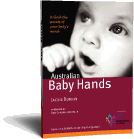Baby Sign Language & Children with Communication Difficulties
When I first launched Australian Baby Hands, people associated its use to teaching deaf children sign language. As time passed, people became aware of the benefits and international research of using baby sign language with hearing children. Nowadays, I get frequently asked is there any benefit in teaching my baby sign language if they have developmental delays or communication difficulties, and the answer is YES.
Apraxia, Autism, Cerebral Palsy, Communication Impairments, Reading Disabilities, Down Syndrome, Hearing Impairment, Language Learning Disability, Medical Non-Verbal Delays such as tracheotomy. Children with special needs such as those listed have experienced the benefits of using baby sign language in their home. The development of speech, language, social, emotional and academic skills is enhanced through the use of baby sign language.
I have had many speech therapists recommend the use of baby sign language with children who are experiencing difficulty communicating verbally. Baby sign language provides these children with a communication tool while strengthening the ability to produce expressive speech. As baby sign language reduces frustration, it results in less temper tantrums.
Many children with speech, language and communication difficulties take a longer time to understand spoken information than most children. Using baby sign language in conjunction with spoken language provides your child with two forms to process the information: auditory and visual. When you use sign language, you are inclined to slow your spoken word down which also gives your child more time to process what it is you are trying to say.
The benefits of baby sign language for special needs children is the same for that of a hearing child and there has been research with different groups of children listed below that has highlighted these results.
To get started, start with a handful of signs and be consistent with those signs. Start simply and slowly. To help you on the road you can refer to my article on the 10 Steps to Signing Success. And remember, have fun.
Happy Signing!
Below is a list of the studies conducted with various groups of children for your reference:
Autism
Stephen M. Edelson, Ph.D., from the Center for the Study of Autism, Salem, Oregon writes:
“Signed Speech may, at the very least, allow the person to communicate using signs and may stimulate verbal language skills. When teaching a person to use sign language, another possible benefit may be the facilitation of their attentiveness to social gestures of others as well as of themselves.”
Dr. Edelson’s article is available online at http://www.specialneedsnurse.org/page9.html
Down Syndrome
Donovan, Claire S-LP, (1998) Teaching Sign Language, Disability Solutions, Volume 2, Issue 5, January/February 1998.
Watson, Claire S-LP, (1996) Total Communication Options for Children with Down Syndrome in the Context of Hanen Programs for Parents. Wig Wag Winter 1996.
Hopmann, Marita R., (1993) The Use of Signs by Children with Down Syndrome. Down Syndrome Today Volume 2, Number 2, 22-3. Available online at https://www.csdsa.org/artsigns.asp
Miller J F, Sedey A, Miolo G, Rosin M, Murray-Branch J (1992) Vocabulary acquisition in young children with Down syndrome: Speech and sign Paper presented at the 9th World Congress of the International Association for the Scientific Study of Mental Deficiency. Queensland Australia August 1992.
Gibbs, E.D., Springer, A.S., Cooley, S.C. & Aloisio, S. (November, 1991). Early use of total communication: Patterns across eleven children with Down Syndrome. Paper presented at the meeting of the International Early Childhood Conference on Children with Special Needs, St. Louis, MO.
Reading Disabilities
Sensenig, L., Topf, B., and Mazeika, E. (June 1989). Sign Language Facilitation of Reading with Students Classified as Trainable Mentally Handicapped. Education and Training of the Mentally Retarded, 121-125.
Blackburn, D., Vonvillian, J., and Ashby, R. (January 1984). Manual Communication as an Alternative Mode of Language Instruction for Children with Severe Reading Disabilities. Language, Speech and Hearing Services in Schools, 15, 22-31.
Carney, J., Cioffi, G., and Raymond, W. (Spring 1985). Using Sign Language For Teaching Sight Words. Teaching Exceptional Children. 214-217.
Vernon, M., Coley, J., Hafer, J., and Dubois, J. (April 1980). Using Sign Language to Remediate Severe Reading Problems. Journal of Learning Disabilities, 13, 215-218.
Tracheotomized Infants
Hall, SS Weatherly KS, (1989) Using sign language with tracheotomized infants and children, Pediatric Nurse, Jul-Aug: 15(4): 362-7. Available online at: https://www.ncbi.nlm.nih.gov.
